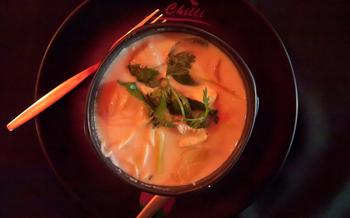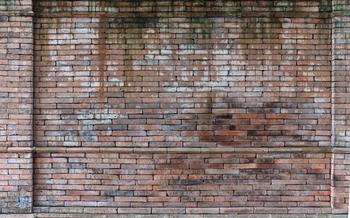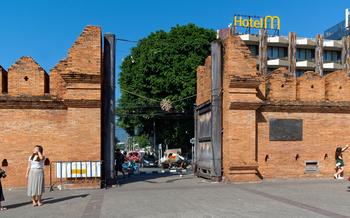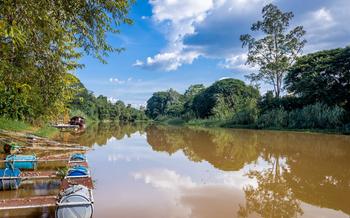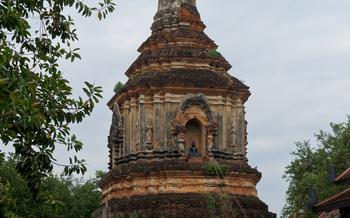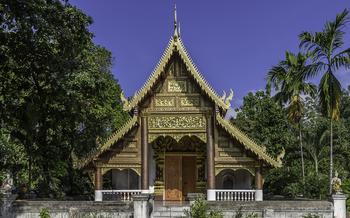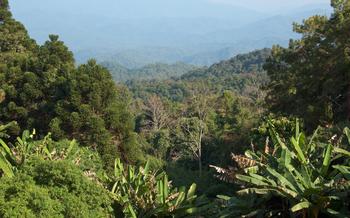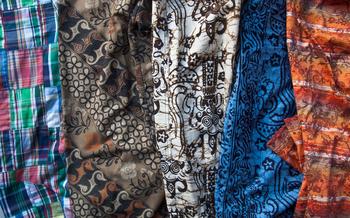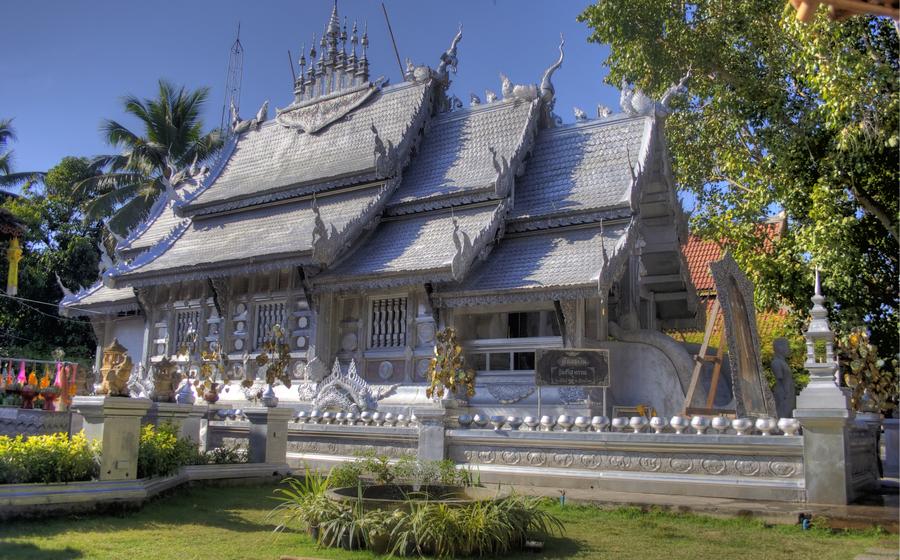
Wat Sri Suphan
- History
- Location and Accessibility
- The Unique Silverwork
- Historical Significance
- Craftsmanship
- Motifs and Symbols
- Restoration Efforts
- Paying Homage to the Buddha
- Exploring the Temple Grounds
- Taking a Guided Tour
- Attending a Festival or Special Event
- Dress Code and Etiquette
- Photography and Videography
- Mindful Travel Tips
- Nearby Attractions
- Suggested Itinerary for a Day Trip
- Accommodations and Dining Options
- Insider Tip: Hidden Gem
History
Wat Sri Suphan, also known as the Silver Temple, is a stunning Buddhist temple located in Chiang Mai, Thailand. The temple's remarkable architecture and intricate silverwork have made it a popular tourist destination and a significant landmark in the city. The construction of Wat Sri Suphan began in the early 20th century, under the patronage of a wealthy local silversmith named Changkham. Changkham was deeply devoted to Buddhism and sought to create a temple that would reflect the beauty and artistry of his craft. He employed skilled artisans from around the region to work on the temple's intricate silverwork, which took over 10 years to complete. Wat Sri Suphan was officially opened to the public in 1935 and has since become one of the most visited temples in Chiang Mai.
Location and Accessibility
Wat Sri Suphan's location, situated in the vibrant city of Chiang Mai, Thailand, welcomes travelers with ease. It is conveniently situated just a short distance from various transportation hubs, making it easily accessible. To reach this enthralling temple, visitors can embark on a leisurely walk from the Old City, immersing themselves in the bustling atmosphere and vibrant streetscapes that characterize this charming neighborhood. Alternatively, for those seeking a more direct route, a quick songthaew ride from the city center offers a convenient and affordable option.
Address: Wat Sri Suphan, 100 Moo 1, Tambon Si Phum, Amphoe Mueang Chiang Mai, Chang Wat Chiang Mai 50200, Thailand.
Hours of Operation: - Daily: 8:00 AM – 5:00 PM
Admission Fees: - Entrance to the temple is free of charge, allowing visitors to explore its wonders without financial constraints. However, donations are gratefully accepted and contribute to the upkeep and preservation of this sacred site.
The Unique Silverwork
Wat Sri Suphan is renowned for its exquisite silverwork, a unique and striking feature that sets it apart from other temples in Thailand. The intricate silver decorations adorning the temple's structures are a testament to the exceptional craftsmanship and artistry of local silversmiths.
Historical Significance
The tradition of silver crafting in Wat Sri Suphan dates back to the late 19th century when a group of skilled silversmiths from the Karen hill tribe settled in the area. They brought with them their knowledge and expertise in metallurgy, which they used to create intricate silver ornaments for the temple.
Craftsmanship
The silverwork at Wat Sri Suphan is characterized by its intricate designs, meticulous craftsmanship, and the use of traditional techniques. The silversmiths employ a variety of tools and techniques, including hammering, embossing, and engraving, to create intricate patterns and motifs on silver sheets. The resulting artwork is a testament to their patience, skill, and dedication.
Motifs and Symbols
The silverwork at Wat Sri Suphan features a variety of motifs and symbols that hold cultural and religious significance. Common motifs include flowers, animals, and mythical creatures, which are often depicted in intricate detail. These motifs symbolize various aspects of Buddhist teachings, such as the cycle of life, the impermanence of all things, and the pursuit of enlightenment.
Restoration Efforts
Over the years, the silverwork at Wat Sri Suphan has undergone several restoration projects to preserve its beauty and historical significance. In recent decades, the temple has collaborated with skilled craftspeople and artisans to restore and repair damaged silver ornaments and create new pieces that complement the existing artwork. These efforts ensure that the temple's unique silverwork continues to shine for generations to come.
Paying Homage to the Buddha
Buddha Statues in Wat Sri Suphan Wat Sri Suphan is home to several revered Buddha statues, each with its unique history and significance. The most prominent statue is the Phra Chao Thong Tham, a towering silver Buddha that serves as the temple's main deity. Standing over 5 meters tall, this majestic Buddha exudes an aura of serenity and compassion. Other notable statues include the Phra Luang Por Chaichumpol, believed to possess miraculous powers, and the Phra Nang Phaya, representing the female aspect of the Buddha.
Offerings and Rituals Devotees pay homage to the Buddha through various offerings and rituals. Visitors can purchase gold or silver leaf sheets to apply to the Buddha statues, a symbolic act believed to bring good fortune and merit. Lighting incense sticks and candles is another common practice, as the fragrant smoke is said to carry prayers and wishes to the heavens. Devotees also make offerings of flowers, lotus buds, and food to express their gratitude and devotion.
Etiquette and Respect When visiting Wat Sri Suphan, it is essential to observe proper etiquette and show respect for the temple and its sacred objects. Visitors should dress modestly, covering their shoulders and knees, and remove their shoes before entering the temple grounds. It is considered disrespectful to point one's feet towards the Buddha statues or to touch them without permission. When making offerings, do so with a sincere and humble heart, remembering that the act of giving is more important than the material value of the offering.
The Meaning of Merit-Making In Buddhism, the concept of merit-making, or "tham bun," plays a crucial role. By performing good deeds and offering to the Buddha, devotees accumulate merit, which is believed to have a positive impact on their karma and future lives. Merit-making is not only about personal gain but also about expressing gratitude and contributing to the well-being of the community. The act of giving to the Buddha is seen as a way of showing appreciation for the teachings and guidance that lead to enlightenment and liberation from suffering.
Exploring the Temple Grounds
Wat Sri Suphan's layout is both intricate and inviting, offering visitors a journey through its spiritual and architectural wonders. The main sanctuary stands as the centerpiece, housing the revered silver Buddha statue. Its intricate silverwork and delicate features captivate the eye, inspiring awe and devotion.
Beyond the main sanctuary, a sacred Bo tree, a descendant of the original Bodhi tree under which the Buddha attained enlightenment, provides a tranquil oasis. Its lush foliage offers a respite from the bustling temple grounds, inviting visitors to pause and reflect upon the Buddha's teachings.
The bell tower, with its distinctive silver spire, stands as a symbol of mindfulness and the passage of time. Its melodious chimes reverberate through the temple complex, calling the faithful to prayer and meditation.
Smaller shrines dedicated to various deities and spirits are scattered throughout the grounds, each with its unique offerings and rituals. Visitors can explore these shrines, paying homage to the diverse pantheon of Buddhist and animist beliefs that coexist harmoniously at Wat Sri Suphan.
Other structures of note include the viharn, a multi-purpose hall used for ceremonies and gatherings, and the kuti, simple dwellings where monks reside. These buildings provide a glimpse into the daily lives of the temple's monastic community.
As you wander through the temple grounds, take time to appreciate the intricate details and symbolism embedded in every corner. The silver stupas, representing the Buddha's relics, shimmer in the sunlight, while the mythical creatures guarding the temple gates serve as reminders of the unseen realms that intertwine with the mortal world.
Taking a Guided Tour
Navigating the intricate history and symbolism of Wat Sri Suphan can be greatly enhanced by booking a guided tour. These tours, led by knowledgeable local experts, provide in-depth insights into the temple's construction, unique silverwork, and cultural significance. They also offer a deeper understanding of the Buddhist beliefs and practices associated with the temple, creating a more immersive and meaningful experience for visitors.
Benefits of a Guided Tour:
Expert Knowledge: Guides share their extensive knowledge about the temple's history, architecture, and cultural significance, ensuring that visitors gain a comprehensive understanding of the site.
In-depth Explanations: Guides provide detailed explanations of the various silver motifs and symbols found throughout the temple, helping visitors appreciate the intricate artistry and symbolism.
Cultural Context: Guides offer insights into the Buddhist beliefs and practices associated with Wat Sri Suphan, allowing visitors to gain a deeper understanding of the temple's religious significance.
Personalization: Small group or private tours allow for a more personalized experience, where guides can tailor their explanations to the interests and questions of the participants.
Available Tour Options:
General Temple Tour: This tour provides a comprehensive overview of the temple's history, architecture, and cultural significance, covering the main highlights of Wat Sri Suphan.
Silverwork and Craftsmanship Tour: This tour focuses specifically on the temple's unique silverwork, exploring the techniques and symbolism behind the intricate designs.
Buddhism and Rituals Tour: This tour delves into the Buddhist beliefs and practices associated with the temple, explaining the significance of rituals, offerings, and merit-making.
Booking and Prices:
Guided tours can be booked in advance through local tour operators or online platforms. Prices vary depending on the tour type, group size, and duration, typically ranging from 200 to 500 Thai baht per person.
Insights into the Temple's History:
Guides often share fascinating stories and anecdotes about the temple's history, providing a glimpse into the lives of the artisans, monks, and devotees who have shaped Wat Sri Suphan over the centuries.
Attending a Festival or Special Event
Wat Sri Suphan comes alive during festivals and special events, offering a vibrant and immersive cultural experience.
The most prominent celebration is Visakha Bucha, held in May, which commemorates the birth, enlightenment, and passing of the Buddha. The temple is adorned with colorful decorations, and monks lead processions and chantings. Visitors can participate in merit-making ceremonies, listen to Dharma talks, and witness traditional Thai performances.
Songkran, the Thai New Year, is celebrated in April and features water-throwing festivities. Wat Sri Suphan hosts a grand water blessing ceremony, where devotees and visitors alike receive blessings from monks and splash water on each other, symbolizing purification and renewal.
During Loi Krathong in November, the temple organizes a beautiful floating lantern festival. Visitors can make and release their own krathongs, small decorated floats, into the nearby river, carrying their wishes and prayers to the heavens.
To make the most of your visit, check the temple's website or local tourism offices for upcoming festivals and events. Remember to dress respectfully and follow local customs during these celebrations.
Dress Code and Etiquette
When visiting Wat Sri Suphan, it's essential to adhere to appropriate dress code and etiquette to show respect for the sacred nature of the temple. Dressing modestly and conservatively is expected, with shoulders and knees covered. Avoid wearing shorts, tank tops, or revealing clothing. Before entering the temple, remove your shoes and place them neatly in the designated shoe racks. Remember that the temple is a place of worship and reflection; maintain a respectful demeanor, avoiding loud noises and unruly behavior. Smoking and chewing gum are strictly prohibited within the temple grounds.
Photography and Videography
Respecting the Sanctity of the Temple
Photography and videography are generally allowed at Wat Sri Suphan, but it is important to prioritize respect and mindfulness. Remember that this is an active temple where locals come to pray and meditate. Be considerate of their spiritual practices and avoid creating disruptions.
Choose your angles carefully to avoid capturing people in prayer or meditation without their consent. If you want to take a portrait of a monk or local, always ask permission first and be respectful of their wishes.
Guidelines for Taking Photos and Videos
- No Flash Photography:
Flash photography is not allowed inside the temple as it can be disruptive and disrespectful. The soft, natural light inside the temple creates a beautiful ambiance, so consider using that instead.
- Avoid Tripods and Selfie Sticks:
While tripods and selfie sticks can be helpful for taking group photos or capturing certain angles, they can also be cumbersome and intrusive in a crowded temple. Try to keep your camera steady or use a handheld stabilizer if needed.
- Document the Details:
Take your time to capture the intricate details of the silverwork and other architectural elements. Zoom in on the intricate patterns and motifs to showcase the craftsmanship and artistry that went into creating this unique temple.
- Capture the Atmosphere:
In addition to close-up shots, take a step back to capture the overall atmosphere of the temple. Photograph the serene courtyard, the rows of silver stupas, and the surrounding lush greenery.
Mindful Travel Tips
As responsible travelers, it's essential to practice mindful tourism when visiting Wat Sri Suphan and Chiang Mai. Here are some tips to ensure your journey is sustainable and respectful:
-
Sustainable Tourism Practices: Choose tour operators committed to responsible practices, including minimizing environmental impact, supporting local communities, and preserving cultural heritage.
-
Supporting Local Crafts and Businesses: Purchase souvenirs and handicrafts from local artisans to support their livelihoods and preserve traditional skills.
-
Respecting the Local Culture and Traditions: Familiarize yourself with Thai customs and traditions before your visit. Be mindful of local dress codes, customs, and religious practices.
-
Responsible Wildlife Encounters: If visiting elephant sanctuaries, choose reputable organizations that prioritize the well-being and ethical treatment of the animals. Avoid riding elephants, as it can be harmful to their health.
Nearby Attractions
Beyond Wat Sri Suphan, Chiang Mai offers a wealth of attractions to explore. Just a short walk away, you'll find the equally stunning Wat Photharam, famous for its intricate murals depicting scenes from Thai mythology. For a glimpse into local life, head to the vibrant Chang Klan Road Night Market, where you can savor delicious street food, browse handmade crafts, and soak in the lively atmosphere.
For those interested in history and culture, the Chiang Mai National Museum showcases an extensive collection of artifacts and exhibits chronicling the region's rich heritage. If you're seeking a tranquil retreat, immerse yourself in the beauty of the Huay Tung Tao Lake, where you can take a leisurely stroll or relax by the serene waters.
Elephant enthusiasts can visit the nearby Elephant Nature Park, a sanctuary dedicated to rescuing and rehabilitating these majestic creatures. Here, you'll have the chance to observe elephants in their natural habitat and learn about conservation efforts. For a unique cultural experience, don't miss the Khantoke Dinner Show, where you can indulge in a traditional Thai feast while enjoying mesmerizing performances of Lanna dances and music.
Suggested Itinerary for a Day Trip
To make the most of your visit to Chiang Mai, consider dedicating a full day to exploring Wat Sri Suphan and its surroundings. Here's a suggested itinerary:
Morning: - Start your day early to beat the crowds and the heat. - Visit Wat Sri Suphan and explore the temple grounds, marveling at the intricate silverwork and paying homage to the Buddha statues. - Learn about the history and cultural significance of the temple from a guide or through informative signs. - Take your time to admire the unique architecture and motifs of the temple, capturing the beauty of the silverwork through photographs.
Afternoon: - After a fulfilling morning at Wat Sri Suphan, head to the Old City of Chiang Mai, a short walk away. - Wander through the charming streets, discovering ancient temples, traditional houses, and vibrant markets. - Visit the Chiang Mai City Arts & Cultural Center to learn about the region's rich history and culture. - Enjoy a delicious lunch at one of the many local restaurants or street food stalls in the Old City.
Evening: - As the day winds down, return to the area near Wat Sri Suphan to experience the vibrant Night Market. - Indulge in a traditional Thai dinner at one of the many street food stalls, savoring the authentic flavors of northern Thailand. - Browse the stalls selling local crafts, souvenirs, and clothing, taking home a piece of Chiang Mai's vibrant culture. - End your day with a leisurely stroll along the Ping River, soaking in the peaceful atmosphere and reflecting on your enriching day in Chiang Mai.
Accommodations and Dining Options
Wat Sri Suphan's central location makes it easy to find nearby accommodations and dining options that suit every budget and preference. For a luxurious stay, consider the five-star Akyra Manor Chiang Mai, just a short walk from the temple. Alternatively, the budget-friendly Baan Orapin Guest House offers comfortable rooms with traditional Thai décor.
When it comes to dining, the streets surrounding Wat Sri Suphan are lined with mouthwatering options. Indulge in authentic Thai cuisine at local restaurants like Khao Soi Mae Sai, renowned for its flavorful Khao Soi noodle soup. For a quick and affordable bite, try the street food stalls that serve up delicious Pad Thai, grilled meats, and tropical fruits.
For those seeking vegetarian or vegan options, Chiang Mai has a thriving plant-based culinary scene. Head to the cozy Earth Tone Café for a variety of healthy and flavorful dishes, or explore the many vegan street food stalls scattered throughout the city.
To truly immerse yourself in the local culture, consider taking a cooking class and learning to prepare traditional Thai dishes using fresh ingredients from the market. This is a fantastic way to bring back a taste of Chiang Mai to your home kitchen.
Insider Tip: Hidden Gem
Beyond the main temple grounds, nestled amidst lush greenery, lies a hidden gem – a tranquil corner where visitors can find solace and immerse themselves in meditation and reflection. This secluded spot, known only to a few, offers a profound experience of inner peace and serenity. As you step into this sacred space, you'll be greeted by the gentle sounds of nature and the soft rustling of leaves, creating an atmosphere conducive to deep contemplation. Whether you seek spiritual guidance, a moment of introspection, or simply a respite from the bustling city, this hidden gem within Wat Sri Suphan awaits your discovery.
